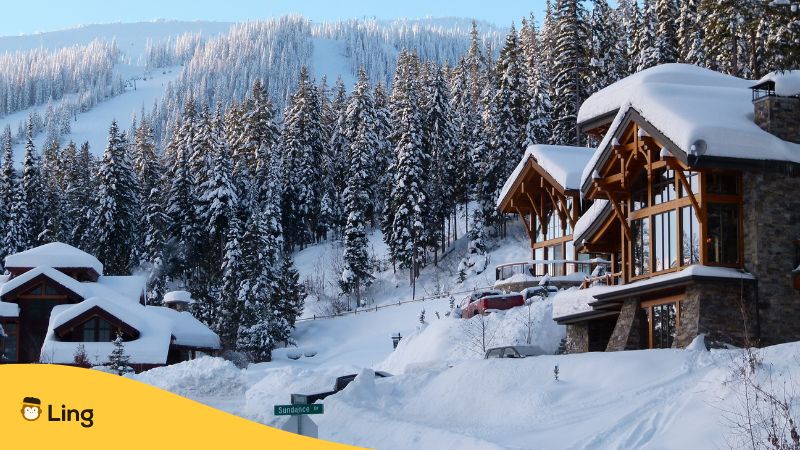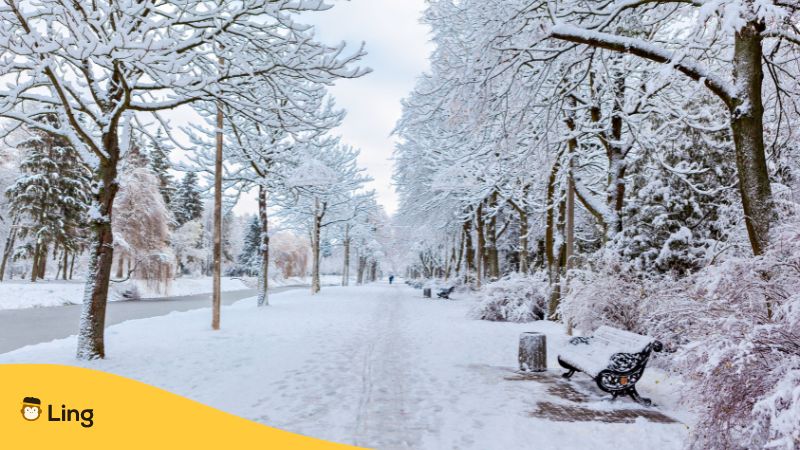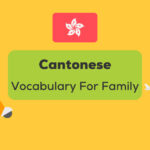Ever thought about grabbing a croissant, putting on your chicest beret, and diving deep into the French words for snow while sipping on a warm cup of chocolat chaud? Yeah, we did too. Snow or la neige isn’t just that fluffy white stuff you see outside your window or the reason you’re late for work in the winter. Want to learn more about this? Keep reading below!
Winter in France is nothing short of enchanting. I remember the first time I strolled through the streets of Paris, blanketed under a soft layer of pristine snow. The Eiffel Tower, shimmering against the backdrop of the wintery night sky, looked like something out of a fairy tale. The delicate snowflakes falling on the cobblestone streets seemed to whisper the tales of centuries gone by. But it wasn’t just the mesmerizing scenery that captivated me; it was the language!
Every snowfall, from the powdery dustings to the thick layers perfect for building snowmen, had its own name. Discovering the rich array of French words for snow opened a door to understanding not just the climate but the culture and soul of the nation. The importance of learning these words goes beyond vocabulary – it’s about immersing oneself in the very essence of a French winter wonderland.
So if you are truly interested in visiting Paris and experiencing the actual snowy weather, then you’ve got to remember the French translations we will cover in this post! Let’s begin!

What Is Snow In French?
Snow, that mesmerizing white fluff that transforms landscapes and evokes a myriad of emotions, has a simple yet beautiful name in the French language: “Neige” (pronounced nayzh). The word itself is soft and poetic, much like the feeling of watching the snow gently fall from the sky. It’s important to clarify that “neige” (snow) is a noun in French, so it doesn’t have verb conjugations like verbs do. Instead, nouns in French have singular and plural forms, and they can take on different genders, either masculine or feminine.
The word “neige” is feminine. Here’s its basic form:
- Singular: neige (snow)
- Plural: neiges (snows)
However, if you’re interested in verb conjugations, perhaps you are thinking of the verb “neiger” which means “to snow.” Additionally, it’s worth noting that in everyday French, people usually use the impersonal form “il neige” which simply means “it is snowing.” The verb “neiger” is primarily used in the third-person singular form, similar to how we use “it snows” in English.
Basic Sentence Patterns Using Snow In French
Venturing into the linguistic world of snow in France? Let’s build some foundational sentences! After all, the beauty of the French language lies in its melodic intonation and intricate structures. Here are some fundamental sentence patterns using “neige” to get you started:
- Affirmative Sentences:
- Il neige. – It is snowing.
- La neige est blanche. – The snow is white.
- J’aime la neige. – I love the snow.
- Negative Sentences:
- Il ne neige pas. – It is not snowing.
- Je n’aime pas la neige. – I don’t like the snow.
- Questions:
- Est-ce qu’il neige? – Is it snowing?
- Aimes-tu la neige? – Do you like the snow?
- Où est la neige? – Where is the snow?
- Comparative Sentences:
- Il y a plus de neige cette année. – There is more snow this year.
- La neige d’aujourd’hui est moins épaisse que celle d’hier. – Today’s snow is less thick than yesterday’s.
- Descriptive Sentences:
- La neige recouvre tout. – The snow covers everything.
- La neige fond rapidement. – The snow is melting quickly.
- Future and Past References:
- Il va neiger demain. – It will snow tomorrow.
- Il a neigé hier. – It snowed yesterday.
These patterns will not only help you convey simple thoughts about snow in French but also serve as a foundation to explore more complex expressions. Whether you’re describing a winter wonderland or simply chatting about the weather, mastering these basic structures will make your French sound more fluent and natural.

French Words For Snow Types
In France, snow isn’t just a blanket of white that envelops the world in silence; it has its own shades of meaning, textures, and moods. Different snowfalls create varied landscapes and experiences, and the French language captures this beautifully with a range of terms. Here’s a guide to help you navigate the snowy lexicon of French:
- Neige fraîche (pronounced nayzh fray-sh) – Fresh Snow
- This is the soft, powdery snow that falls gently and covers the ground like icing sugar. It’s a favorite for snowball fights and creates that iconic crunch underfoot.
- Neige fondue (pronounced nayzh fon-doo) – Melting or Slushy Snow
- This is when the snow starts melting and turns to slush. It’s often seen during warmer periods in winter or in city streets due to the mix of snow with salt and other elements.
- Neige poudreuse (pronounced nayzh poo-druhz) – Powdery Snow
- This is the light, fluffy, and dry snow, ideal for skiing and snowboarding. It’s what winter enthusiasts dream of when they think of perfect ski conditions.
- Neige tassée (pronounced nayzh tah-say) – Packed Snow
- This is snow that has been compressed, either due to being trodden on or as a result of other natural factors. It’s common on well-used pathways and ski slopes.
- Averse de neige (pronounced ah-vers de nayzh) – Snow Shower
- A brief, sometimes intense, period of snowfall, much like a rain shower but with snow.
- Congère (pronounced kohn-zhair) – Snowdrift
- These are accumulations of wind-blown snow, often creating large mounds or banks, especially beside roads or against obstacles where the wind is obstructed.
- Grêle (pronounced grayl) – Hail
- Not exactly snow, but it’s a winter phenomenon worth mentioning. These are hard balls or lumps of ice that fall like rain. They can range from tiny to very large and can sometimes be damaging.
Being familiar with these terms not only allows one to accurately describe different snow conditions but also paints a more vivid picture of the winter landscape. So, the next time you’re watching a French film or reading a French book set in winter, you’ll appreciate the nuance and beauty of the country’s snowfall vocabulary.
Learn French With Ling
Ah, the joy of discovering the layers of a language! Isn’t it fascinating how every snowflake, though unique, comes together to paint the vast white tapestry of winter? In the same way, every word we learn in French adds depth, color, and nuance to our conversations.
Now, if our snowy sojourn has kindled your curiosity for French, and you’re itching to dive deeper, we have a recommendation for you. Why stop at snow when the world of French vocabulary is vast and vibrant? Try out the Ling. It’s an excellent tool for those who wish to expand their horizons, learn more advanced vocabulary, and truly immerse themselves in the beauty of the French language.
Remember, every word learned is a step closer to fluency and a bridge to understanding a culture rich in history, art, and, of course, mesmerizing winters. So, why wait? Start your journey with the Ling app by downloading it from the App Store or Play Store now!



































































